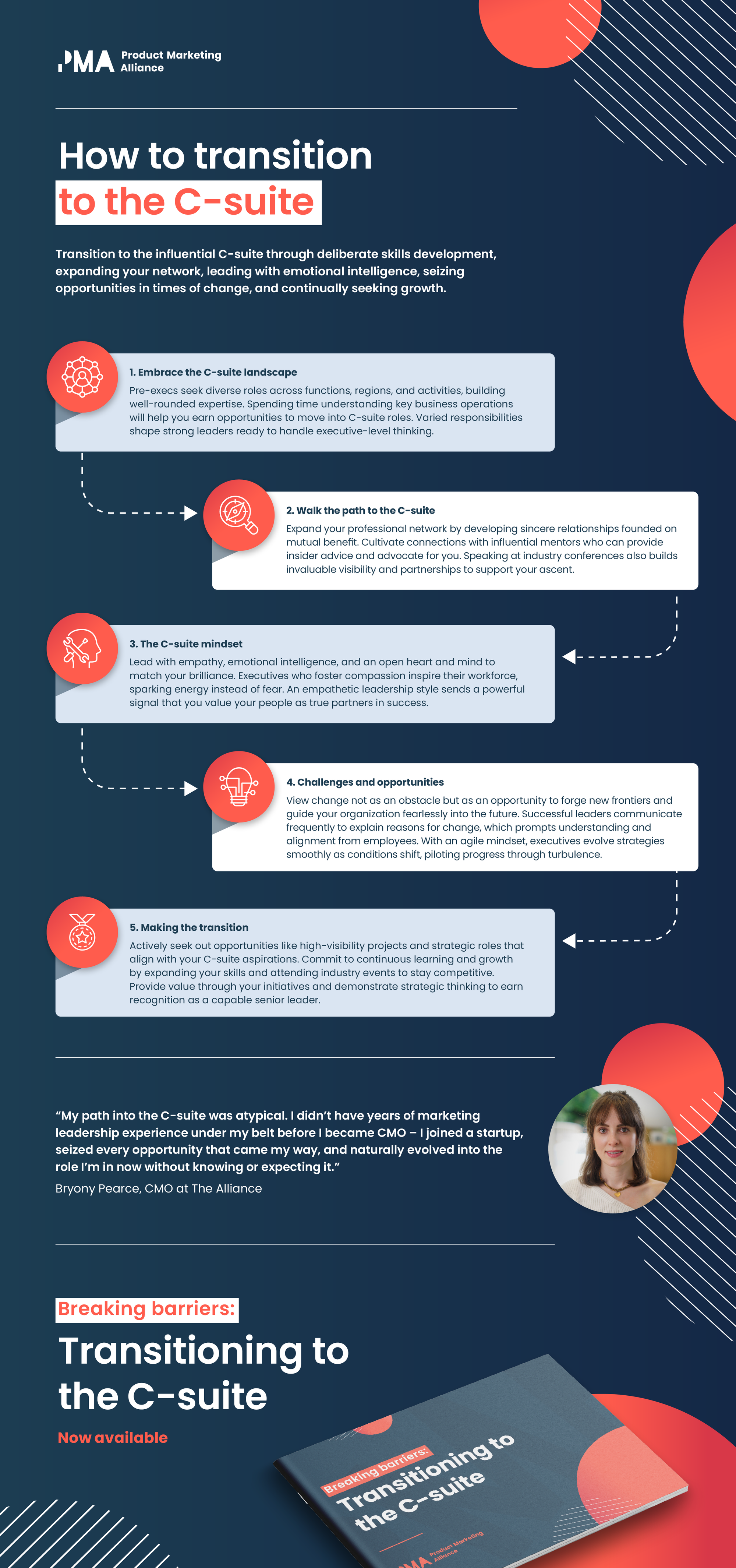Landing a spot in the coveted C-suite is the pinnacle of success for many business professionals. But the path to these elite corporate leadership positions like CEO, CRO, and CMO is not always clear.
While each person's journey is unique, there are common experiences and preparations that can set you up for C-suite success. In this article, we’ll explore the typical routes to the top and how you can thoughtfully chart your own course to become a strong C-suite candidate.
Becoming a strong C-suite candidate
Transitioning from functional leader to elite C-suite executive is a significant step. Preparing for this role progression requires dedication across several areas.
TL;DR: Here are the key steps to prepare for C-suite success:
- Get educated – Formal learning builds business acumen and leadership capabilities.
- Gain broad experience – Diverse functional and global roles build well-rounded expertise.
- Think strategically – Analyze landscapes and craft growth plans like a C-suite leader.
- Expand your network – Cultivate connections and visibility through speaking, boards, and mentors.
- Navigate change – The world of an exec is fast-paced and ever-changing. You need to keep up with the times, disrupt, and embrace innovation.
With diverse expertise, strategic sight, and a strong network, product marketers can become well-rounded C-suite candidates ready to take the reins from the top level.
If you’re keen to learn more about how you can set yourself up for C-suite success, let’s get into it.
Laying the educational groundwork
Having a solid educational background is key to executive leadership. It gives you the skills and knowledge you need to take charge with confidence.
While there are no absolute requirements, many C-suite executives boast advanced degrees like MBAs. This helps them gain the advanced business acumen and cross-functional perspective required for executive-level strategic thinking.
53.1% of the product marketers we spoke to in our 2022 Global Product Marketing Salary Survey, have a bachelor’s degree as their highest qualification and earn an average salary of $124,065 per year.
Programs that offer management-focused courses can be particularly helpful for building expertise in areas like finance, marketing, operations, and more that are essential for C-suite roles.
That said, higher education isn't the only path forward. Many successful executives learned on the job and gained practical experience to expedite their growth into C-suite positions.
Regardless of your background, here are some options to build your capabilities:
- Attend executive leadership programs or governance training to expand your skills in areas like strategy, decision-making, and boardroom leadership. Some companies even sponsor rising stars for these intensive learning experiences.
- Seek out certifications or courses in management, marketing, finance, and other critical business functions. This can supplement gaps in formal education.
Gaining diverse and broad experience
C-suite members tend to have worn many professional hats on the way up the ladder. A diverse mix of responsibilities across functions builds the well-rounded expertise key for the climb to the top.
This means getting hands-on experience in activities like:
- Managing new product launches to hone go-to-market (GTM) strategies
- Leading high-performing teams to build people management skills
- Overseeing profit and loss (P&L) for business units to understand financial impacts
“My path into the C-suite was atypical. I didn't have years of marketing leadership experience before I became CMO – I joined a startup, seized every opportunity that came my way, and naturally evolved into the role I'm in now without expecting it.”
– Bryony Pearce, CMO at The Alliance
Gaining global expertise with international postings is also valuable. These roles build perspective and cross-cultural savvy crucial for C-suite leadership.
Here are some tips to build a diverse experience:
- Spend time in operational roles to understand key business functions. Companies often hire C-suite executives from within.
- Seek opportunities to work across departments like sales, product, engineering, etc. This develops cross-functional fluency.
- Take on stretch assignments and projects outside your comfort zone. This builds new capabilities.
- Pursue global assignments to expand your worldview and leadership abilities.
- Earn certifications and accreditations to add diverse skills to your portfolio.
- Attend summits and conferences to build connections and knowledge.
As you take on new challenges, fully immerse yourself. Drive results, make tough calls, and seize opportunities to showcase leadership potential.
Developing strategic thinking
You won't just oversee operations at the C-suite level – you'll shape overall strategy. This requires a sharp analysis of the competitive landscape and growth opportunities.
C-suite leaders don't just observe industry happenings. They translate insights into executable strategic plans.
Here are some tips to build strategic thinking:
- Shadow C-suite leaders to understand high-level strategic decision-making.
- Analyze market trends and scenarios to enhance perspective.
- Spearhead growth projects to get hands-on strategic experience.
- Develop the capability to distill complex issues into concrete actions.
- Take part in strategic planning sessions to absorb and contribute insights.
- Enroll in courses on business strategy and leadership principles.
As you craft strategy, keep the big picture in mind. Weigh impacts, validate with data, and ensure alignment with customer needs and business goals.
Expanding your network
Connections and visibility are vital for rising to the top. Many talented professionals fail to advance because they simply haven’t mastered the art of networking and building connections. But done right, networking creates bonds that support your ascent.
In the early stages of your career, you’ll likely focus on honing functional skills and delivering results. But hard work alone isn't enough. People advance based on relationships and sponsorship from influential leaders.
Here are some tips for expanding your network:
- Seek out an executive mentor who can provide guidance and open doors for you.
- Identify and connect with other high achievers. These relationships provide mutual learning.
- Pursue speaking opportunities at industry conferences. This builds visibility and connections.
- Join professional organizations and networking groups. These provide exposure to new contacts.
- Attend company social events and mixers. Connecting personally strengthens professional relationships.
- Build your personal online brand by sharing insights on professional platforms like LinkedIn.
Prioritize relationship-building throughout your career. With the right mentorship and exposure, you’ll gain the visibility and advocacy needed to reach the top tier.
Navigating common C-suite challenges
Life in the C-suite comes with prestige and influence, but also intense demands. Top executives tackle mountains of responsibilities daily, from overseeing operations to appeasing the board.
Navigating these challenges takes resilience and adaptability.
Let's explore the realities of C-suite leadership and how executives stay effective amid chaos.
Embrace change
Change sweeps through every industry, driven by forces like technology, demographics, and globalization. Organizations must adapt quickly or risk falling behind.
"The rate of change today is not going to slow down anytime soon."
– John Kotter
Effective change management starts with awareness. Leaders must convey the reasons, risks, and benefits to gain buy-in across the company. With clear, consistent communication, employees understand the necessity of change and pivot faster.
Once a sense of urgency is established, it’s time to methodically execute change. Frameworks like ADKAR (Awareness, Desire, Knowledge, Ability, Reinforcement) help implement changes at an individual level.
Though often messy, change brings opportunities. With courage and purpose, executives can guide their organizations into new, uncharted terrain. Real progress means embracing change, not resisting it.
Bridge departmental gaps
There’s often a disconnect between entry-level employees and the C-suite. This gap harms company culture and the flow of information.
Collaboration is key to closing these chasms. Effective collaboration keeps executives connected to ground-level realities. Without it, leaders operate with distorted views of the company's health.
Promoting open communication and human connections across levels is crucial. But bridging the gap is easier said than done. Bureaucracy and hierarchy breed hesitance in sharing concerns.
Executives must foster an environment where people feel safe surfacing issues. They should invite employees to pitch in with problem-solving – that way, they’ll gain insights reports alone can't provide.
With compassion and adaptability, C-suite leaders can dismantle silos. The payoff? Aligned teams, transparent communication, and shared mission across the organization.

Drive innovation
Organizations have to innovate if they want to stay on the cutting edge. But as digital disruptions reshape industries overnight, innovation is both exhilarating and exhausting for leaders.
Executives must regularly re-evaluate strategy in this climate – tracking trends, aiming for disruption, and pivoting rapidly. They realize that to stay competitive, they have to embrace innovation, not resist it.
So, how do leaders foster innovation? By critiquing existing structures and processes that stifle creativity. Silos, hierarchy, and bureaucracy have no place in an agile, innovative culture.
Executives should empower teams at every level to generate ideas while dedicating resources and leadership to guide the innovation strategy.
With this balance of support and guidance, organizations unlock game-changing improvements.
Managing stakeholders
At a company's core are its stakeholders – employees, investors, board members, customers, and partners. When their needs aren't met, relationships unravel and performance suffers.
Skilled leaders meticulously tend to these connections. They engage compassionately, adapt messaging, and keep communication flowing.
Stakeholders provide insights that reports can't match. When executives get everyone involved in solving problems, they're tapping into a well of unique wisdom. Plus, co-creating solutions helps get everyone on board.
But make no mistake – balancing these relationships is a high-stakes challenge. Executives who neglect stakeholders breed discontent. Meanwhile, those who nurture connections reap the rewards of engaged employees, delighted customers, and collaborative partners.
Treat stakeholders like partners sharing the journey, not obstacles in the path. Put people first, understand needs, and cultivate trust. When executives focus on shared success, the entire ecosystem thrives.
The road ahead
In the C-suite, success requires evolution. Visionary executives realize that saying “yes” to change is the only path forward.
It takes resilience to stay agile amid turbulence. As markets and technology relentlessly advance, leaders must continually adapt – rethinking structures, processes, and mindsets.
The climb to the top requires patience, diverse experience, and strategic networking. Once there, insightful leaders see challenges as opportunities and steer their companies through change with agility. By embracing innovation and bringing people together, forward-thinking C-suite execs can create lasting success.
Ready to take action?
With the help of leading experts and access to our Alliance frameworks and case studies, our C-suite masterclass will give you the strategies, insights, and skills you need to thrive in the upper echelons of business.
From developing your leadership abilities to understanding the unique challenges faced by C-level executives, you'll gain the knowledge you need to drive results, inspire teams, and achieve your career aspirations.
By the end of this masterclass, you'll be able to confidently:
📑 Develop exemplary soft skills required for C-suite execs, including but not limited to, resilience, prioritization, time-keeping, business strategies, investment, decision-making, budgets, and emotional intelligence.
✅ Acknowledge and manage cultural differences when leading large teams by assessing the organizational culture to foresee how it may help or hinder change.
💰 Recognize the typical structure of a corporate finance team and the key roles within it.
🔍 Identify the success factors and key components of ‘disruptive leadership’ and a change management approach.
👁 Quickly establish a company-wide vision and framework for developing and implementing a winning strategy.
📊 Identify how organizations achieve hard-to-imagine results in uncertain and volatile times.
🧱 Build effective data visualizations and tell compelling stories about those visualizations that will convince and persuade your employees or board of directors to act.
🧭 Navigate important leadership issues that are often overlooked, like maintaining your mental health, hurdling imposter syndrome, and managing your work/life balance.


 Follow us on LinkedIn
Follow us on LinkedIn
